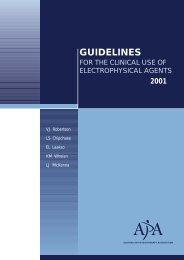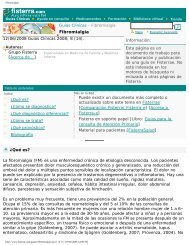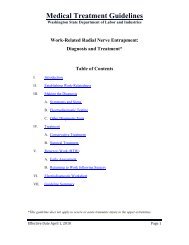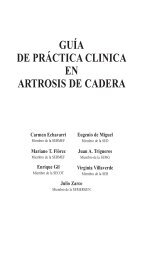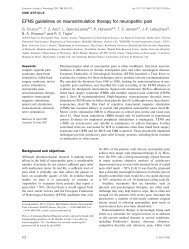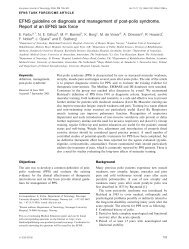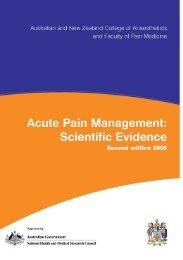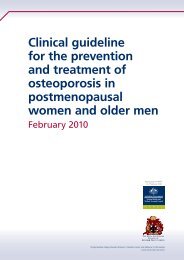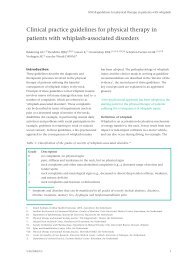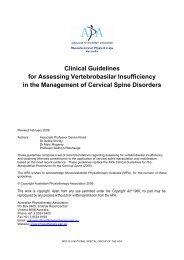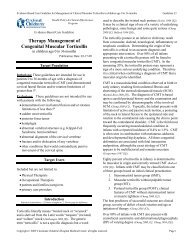Practice Parameter and Literature Review of the Usefulness of ...
Practice Parameter and Literature Review of the Usefulness of ...
Practice Parameter and Literature Review of the Usefulness of ...
You also want an ePaper? Increase the reach of your titles
YUMPU automatically turns print PDFs into web optimized ePapers that Google loves.
<strong>Practice</strong> <strong>Parameter</strong>: Carpal Tunnel Syndromesecond CTS Task Force in 2000 to update <strong>the</strong> 1993 report<strong>and</strong> to provide a single reference for EDX studies in CTS byincluding <strong>the</strong> information from <strong>the</strong> 1993 publication alongwith <strong>the</strong> additional information from a systematic review <strong>of</strong>articles published in English through December 2000.Based on a systematic review <strong>of</strong> <strong>the</strong> literature, thisdocument addresses <strong>the</strong> following key clinical questions:1. In patients clinically suspected <strong>of</strong> having CTS, whatare <strong>the</strong> best EDX studies to confirm <strong>the</strong> diagnosis?2. What improvements can be made to future clinicalresearch studies to evaluate <strong>the</strong> usefulness <strong>of</strong>laboratory studies, including EDX studies, toconfirm <strong>the</strong> diagnosis <strong>of</strong> CTS?AAEM CTS LITERATURE INCLUSION CRITERIAIn <strong>the</strong> fall <strong>of</strong> 1991, <strong>the</strong> AAEM Quality Assurance (QA)Committee adopted 6 criteria <strong>of</strong> scientific methodologyto evaluate CTS literature describing EDX procedures.The AAEM CTS Task Force used <strong>the</strong> same 6 AAEMCTS LIC to update this report. The first 2 criteria applyto all studies <strong>of</strong> diagnostic tests <strong>and</strong> deal with <strong>the</strong> quality<strong>of</strong> evidence <strong>and</strong> reducing bias; <strong>the</strong> remaining 4 criteriadeal with technical <strong>and</strong> analytic issues that are critical to<strong>the</strong> use <strong>of</strong> NCS to document nerve pathology. All <strong>of</strong><strong>the</strong>se criteria are important for a study to determinewhe<strong>the</strong>r or not an NCS is useful to diagnose CTS.1. Prospective study design. A prospective studydesign permits uniform collection <strong>and</strong> analysis <strong>of</strong>data.2.Diagnosis <strong>of</strong> CTS in patient population based onclinical criteria independent <strong>of</strong> <strong>the</strong> EDXprocedure under evaluation. Use <strong>of</strong> clinicalcriteria for <strong>the</strong> diagnosis <strong>of</strong> CTS permitsidentification <strong>of</strong> a defined population in which totest <strong>the</strong> sensitivity <strong>of</strong> <strong>the</strong> EDX procedure toconfirm <strong>the</strong> diagnosis <strong>of</strong> CTS. The clinicalcriteria include a history <strong>of</strong> nocturnal <strong>and</strong>activity-related pain <strong>and</strong> pares<strong>the</strong>sia in <strong>the</strong>affected h<strong>and</strong>, reproduction <strong>of</strong> <strong>the</strong> pares<strong>the</strong>siawith maneuvers that stress <strong>the</strong> median nerve in<strong>the</strong> carpal tunnel (Phalen’s sign/wrist flexion,reverse Phalen’s sign/wrist extension, Tinel’ssign/percussion <strong>of</strong> <strong>the</strong> wrist, carpal tunnelcompression test), sensory deficit limited to <strong>the</strong>distribution <strong>of</strong> <strong>the</strong> median nerve passing through<strong>the</strong> carpal tunnel, <strong>and</strong> weakness <strong>and</strong>/or atrophylimited to <strong>the</strong> median innervated muscles in <strong>the</strong><strong>the</strong>nar eminence. 1,12,244details <strong>of</strong> <strong>the</strong> EDX procedure are necessary (1)to verify <strong>the</strong> results <strong>and</strong> (2) to use <strong>the</strong> procedurein o<strong>the</strong>r clinical laboratories.4. Limb temperature monitored (measuredcontinuously) during nerve conductionprocedures <strong>and</strong> minimum (or range) <strong>of</strong> limbtemperatures reported for both CTS patients <strong>and</strong><strong>the</strong> reference population. The speed <strong>of</strong> sensory<strong>and</strong> motor nerve conduction is temperaturedependent. The use <strong>of</strong> temperature correctionfactors to adjust nerve conduction velocity (CV)measurements made in cool limbs <strong>of</strong> CTSpatients to a reference temperature iscontroversial <strong>and</strong> not recommended. 10,14,185. Reference values for <strong>the</strong> EDX test obtainedei<strong>the</strong>ra. with concomitant studies <strong>of</strong> a referencepopulation, orb. with previous studies <strong>of</strong> a referencepopulation in <strong>the</strong> same laboratory.The results <strong>of</strong> <strong>the</strong> EDX procedure in a referencepopulation are necessary to determine <strong>the</strong>specificity <strong>of</strong> <strong>the</strong> results <strong>of</strong> <strong>the</strong> EDX procedurein CTS patients.6. Criteria for abnormal findings clearly stated<strong>and</strong>, if <strong>the</strong> measurement is a quantitative one,<strong>the</strong> abnormal value is defined in statisticallycomputed terms, e.g., range <strong>and</strong> mean ± 2st<strong>and</strong>ard deviations, from data derived from <strong>the</strong>reference population. Use <strong>of</strong> st<strong>and</strong>ard statisticalterms permits computation <strong>of</strong> <strong>the</strong> sensitivity <strong>and</strong>specificity <strong>of</strong> <strong>the</strong> EDX procedure <strong>and</strong>comparison <strong>of</strong> <strong>the</strong> procedure to o<strong>the</strong>r EDX <strong>and</strong>non-EDX tests for CTS.Description <strong>of</strong> <strong>the</strong> <strong>Review</strong> ProcessThe 6 AAEM CTS LIC were listed on a review sheetfollowed by “yes” or “no” answers to be circled by <strong>the</strong>reviewer to indicate whe<strong>the</strong>r or not an article fulfilledeach criterion; each article was reviewed independentlyby 2 reviewers <strong>and</strong> <strong>the</strong> results were discussed until aconsensus was reached if <strong>the</strong>re was a difference inscoring. The articles were <strong>the</strong>n ranked by <strong>the</strong> number <strong>of</strong>criteria met. Table 1 lists those articles meeting 4, 5, or 6<strong>of</strong> <strong>the</strong> AAEM CTS LIC.EDX studies <strong>of</strong> only normal subjects could meet amaximum <strong>of</strong> 5 <strong>of</strong> <strong>the</strong> 6 AAEM CTS LIC because <strong>the</strong>sestudies do not contain CTS patients (criterion 2).3. EDX procedure described in sufficient detail topermit replication <strong>of</strong> <strong>the</strong> procedure. SpecificMuscle & Nerve Supplement X 2002 S925



